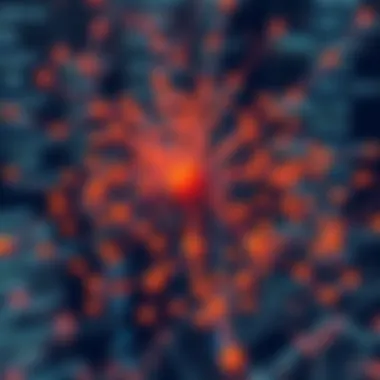Exploring Neo4j Data: Insights into Graph Databases


Intro
In today’s data-centric landscape, understanding the structure and relationships inherent in data is paramount. Traditional relational databases have served their purpose well, but as the scale and complexity of data grow, new paradigms become necessary. This leads us to Neo4j, a prominent player in the realm of graph databases. Neo4j is designed to treat data as a network rather than as discrete tables, which can significantly simplify the relationships between data points. It’s like switching from a linear book to a richly illustrated map—it offers a broader perspective at just a glance.
The beauty of Neo4j lies in its ability to provide immediate insights into the relationships of data, making it highly valued among IT professionals and software developers. As the demand for sophisticated data handling practices escalates, graph databases like Neo4j become more relevant than ever. In this exploration, we will traverse through its architecture, highlight its use cases, discuss the advantages and challenges, and ultimately showcase how this technology can be a game changer for various industries. With that, let's dive deeper into its software overview.
Understanding Neo4j
In today’s ever-evolving technological landscape, understanding Neo4j is paramount for anyone venturing into data-driven solutions, especially in the realm of graph databases. Neo4j, as a pioneer in this field, offers a unique approach to data storage and retrieval that outshines traditional relational databases in several key areas. This section lays the foundation for grasping not only the mechanics of Neo4j but also its broad implications for both small and large businesses, as well as IT professionals.
Graph databases fundamentally alter how data is perceived and organized. While relational databases rely on tables and rows, graph databases structure data in a web of nodes and relationships, showcasing the interconnectedness of information. This visual representation aligns closely with human cognition, making it an intuitive way to interact with data.
"Graph databases are like maps that show us not just the cities (information) but also the roads (relationships) connecting them."
In numerous applications, Neo4j proves its mettle by offering flexibility that standard databases can struggle to achieve. It inherently supports variable schemas, allowing organizations to adjust their data models quickly without the need to disrupt existing workflows. This inherent flexibility can have substantial benefits when adapting to market changes or evolving customer demands.
The advantages of using Neo4j extend beyond flexibility. The efficiency of traversing complex datasets is a defining feature. For instance, when handling large social networks, where each individual is interconnected in numerous ways, querying these relationships proves far faster in Neo4j than SQL-based systems. This rapid relationship querying can lead to better insights during analytics, providing businesses with a competitive edge.
Key Elements
- Efficiency in Data Retrieval: The way data is connected makes it faster to retrieve relationships, enhancing performance in applications demanding real-time insights.
- Flexibility for Evolving Data: Organizations aren’t boxed into fixed schemas, enabling them to adapt their data structure as their needs change.
- Enhanced Relationship Understanding: Navigating massive datasets through graph structures opens doors to deeper insights into customer interactions, which can drive strategic business decisions.
However, with all its advantages, it's vital to weigh these benefits against potential considerations, such as the integration of this database into existing infrastructures and the possible learning curve for teams unfamiliar with graph theories and concepts. Delving deeper into these considerations will help organizations prepare and embrace the graph database revolution with confidence.
Core Architecture of Neo4j
The architecture of Neo4j is like the backbone of a living organism; it sustains and supports all the operations that this graph database can perform. Understanding how Neo4j stores and organizes data is key for both developers and businesses since it impacts everything from performance to the scalability of applications built on this platform. Simply put, its core architecture ensures that Neo4j can handle complex queries and rich data structures effectively.
Data Storage Mechanism
At the heart of Neo4j lies its data storage mechanism, which is crucial for how information is persisted and accessed. This mechanism can be broken down into three primary components: node storage, relationship storage, and property storage. Each of these elements serves a distinct purpose and works in conjunction with the others to optimize data handling.
Node Storage
Node storage serves as the primary unit of data in Neo4j. Each node represents an entity, whether that be a person, place, or concept. Nodes are designed to be lightweight, which means they can be created, modified, or deleted with minimal overhead. The central characteristic of node storage is its ability to manage complex relationships, allowing for efficient and quick access to connected data.
The unique feature of node storage is its flexibility; nodes can easily be expanded by adding new properties, thus accommodating varying data needs without rigid schema requirements. However, one should note that while node storage is efficient, an excessive number of nodes can lead to performance issues, making structured growth planning essential.
Relationship Storage
Relationships in Neo4j are just as important as the nodes themselves. The relationship storage facilitates links between nodes, establishing connections and allowing the database to represent intricate networks of information. The standout characteristic of relationship storage is its directionality; a relationship can be defined as one-way or two-way, offering a nuanced view of connections.
A unique feature here is that relationships contain their own properties. This adds another layer of depth in defining the context of the interaction between nodes. However, complex relationships can sometimes complicate the database’s structure, requiring careful management to avoid system performance hiccups.
Property Storage
Property storage allows both nodes and relationships to have associated attributes. This feature is immensely important since it imbues both nodes and relationships with meaningful descriptions, like names, dates, or values. A key characteristic of property storage is its name-value pair format, enabling flexible and dynamic data structures.


The uniqueness of property storage is that it allows for querying on attributes, facilitating targeted searches and analyses. On the downside, frequent updates to properties may slow down performance, particularly if done en masse. Thus, thoughtful design and indexing strategies may help mitigate this risk.
Query Language: Cypher
Cypher stands out as the query language specially designed for Neo4j. It is specifically created to handle graph data in a way that is both intuitive and expressive. The language leverages ASCII art-style syntax, which gives users a visual representation of the relationships and nodes involved in a query. This makes it significantly different from table-based query languages commonly used in relational databases.
Syntax and Structure
The syntax of Cypher is designed to be user-friendly, aiming to reduce the barrier to entry for new users while still being powerful enough for seasoned developers. The basic structure emphasizes a declarative method to describe the desired outcome rather than procedural steps, which is often found in other languages.
One of the unique features of Cypher is its support for pattern matching. This forms the backbone of querying in Neo4j, allowing users to specify what they want to find without detailing how to find it. This declarative nature can lead to simpler code, but it also means that understanding the underlying data structure becomes vital.
Use Cases for Cypher
Cypher is not just a query tool; it can be a powerful ally in a range of applications. From business intelligence to social network analysis, this query language shines brightest in scenarios that require deep dives into interconnected datasets. Its design allows for easy exploration of complex graphs, making it perfect for tasks like real-time fraud detection or creating recommendation engines.
One of the notable strengths of Cypher is how it can be used for traversing graphs dynamically. It adjusts based on the structure of the data, making it highly adaptable. However, as with any tool, it requires understanding and practice. A novice might struggle at first, particularly when grappling with elaborate queries.
Cypher exemplifies the blend of simplicity and power, enabling users to execute complex queries fluently while maintaining readability.
In summary, understanding Neo4j's core architecture and its distinctive elements—node, relationship, and property storage—is indispensable. The integration of the Cypher query language further enhances the experience of interacting with graph data, unlocking new potentials that make Neo4j a staple in modern data management.
Applications of Neo4j Data
The applications of Neo4j data are as varied as they are impactful across different sectors. Its capacity to map complex relationships within data sets provides an unparalleled advantage for industries that thrive on connection and insight. Organizations increasingly recognize the importance of leveraging graph database technology to foster better decision-making, improve customer interactions, and drive innovation. Here, we delve into specific domains where Neo4j shines and how its unique functionalities contribute to successful outcomes.
Business Intelligence and Analytics
Customer Relationship Management
When it comes to Customer Relationship Management (CRM), Neo4j makes waves by elevating how businesses interact with their clients. The core aspect of its contribution lies in enabling firms to understand customer interactions and preferences in real-time, mapping each customer’s journey through various touchpoints. This leads to more tailored experiences and effective engagement strategies, making it a preferred choice for many organizations.
One significant characteristic of this application is its ability to visualize customer data through relational connections. Imagine a web where each customer is a node, linked by interactions like purchases, service requests, or marketing campaigns. This level of visualization not only simplifies data analysis but also supports predictive analytics. Businesses can anticipate needs, address potential issues, and foster deeper, stronger relationships with their clientele. The uniqueness of Neo4j’s capabilities in this sector lies in its high-level performance when dealing with intricate data relationships, allowing businesses to stay ahead in their game.
However, challenges do exist. The potential disadvantage of adopting Neo4j for CRM could stem from integration issues with existing systems, or the learning curve for users unfamiliar with graph databases. Still, many find that the benefits far outweigh these hurdles.
Fraud Detection
Fraud Detection is yet another critical pillar where Neo4j shows its prowess. In today’s digital landscape, the threat of fraudulent activities looms large over businesses, making robust detection mechanisms essential. Neo4j can track and analyze suspicious transactions by monitoring behavior across an elaborate network of connections.
The standout feature here is the ability to discover hidden patterns that traditional databases may miss. By examining the relationships between entities—like accounts, transactions, and locations—Neo4j identifies anomalies in real time, thus minimizing potential losses. The graph structure is beneficial because it allows for flexible queries that adjust to evolving fraud tactics quickly.
However, it isn't without its trade-offs. Deploying such a system requires a strategic investment in infrastructure, and there’s always that looming necessity to keep the model updated against new fraud detection approaches. Yet, for those entities serious about combating fraud, the advantages offered by Neo4j can be transformative.
Social Network Analysis
Influencer Identification
In the world of social media and connectivity, influencer identification emerges as a high-stakes game. Neo4j allows organizations to dissect social networks to pinpoint individuals with far-reaching influence—a crucial element for marketing strategy and campaign success.


The key characteristic of this application is its pathway analysis, which uncovers how information flows within a network. By examining who holds sway over whom in a sprawling web of connections, brands can strategically partner with influencers to amplify their message. The unique aspect here is not just about finding a popular figure but diving deeper to ascertain who influences that person, creating a ripple effect in outreach.
On the downside, the dynamic nature of social networks can sometimes complicate this analysis. Influencer status can shift rapidly, requiring a continuous assessment to maintain accuracy. Nonetheless, the potential to enhance engagement and brand visibility pays dividends.
Community Detection
Another critical aspect of Social Network Analysis is Community Detection, which addresses how groups form and interact within larger networks. Utilizing Neo4j, businesses and researchers can glean insights into these clusters, facilitating better understanding of shared interests and behaviors.
The primary advantage lies in the granularity it offers. Rather than viewing a network as a homogeneous entity, Neo4j helps reveal the underlying communities that may have unique characteristics and needs. This ability to detect communities assists in tailoring content, marketing efforts, or even product development to match what these clusters are looking for.
However, identifying these communities also requires a robust analytical approach. Challenges may arise from misinterpretation of data or the need for ideal algorithms to analyze the graph effectively. Still, with the right tools and understanding, the payoff can be substantial, leading to more insightful strategies and better engagement.
Recommendation Systems
Recommendation Systems powered by Neo4j exhibit an advanced understanding of users' preferences, allowing businesses to offer personalized suggestions based on robust analysis of user data and interactions. The strength of these systems rests on their ability to utilize the rich data relationships to derive insights that maximize user satisfaction and loyalty.
In this landscape, the flexibility and speed with which Neo4j can connect data points leads to highly relevant recommendations. Whether a user is exploring Netflix for their next binge or looking to buy shoes on Amazon, Neo4j enhances the underlying algorithms that guide those choices, ensuring suggestions feel personal rather than random.
However, implementing effective recommendation systems isn't simple. It mandates careful consideration of user privacy, data storage, and maintaining a balance between providing suggestions without over-stepping boundaries. But with thoughtful execution, the benefits can create loyal customer bases that drive consistent engagement.
Advantages of Using Neo4j
Understanding the advantages of Neo4j is pivotal in appreciating what makes it stand out in the world of graph databases. As businesses increasingly lean towards data-driven decisions, Neo4j offers unique benefits that can enhance data operations, improve analytical capabilities, and boost performance across various applications. Below, we explore some of the crucial advantages of adopting Neo4j, providing clarity on its potential to transform data management and decision-making.
High Performance for Complex Queries
One of the reining attributes of Neo4j has to be its performance when facing intricate queries. Traditional databases often employ tables, which, as data complexity grows, can necessitate time-consuming joins and convoluted queries that can slow down systems. In contrast, Neo4j shines because it utilizes a graph structure. When a query is executed, the engine navigates the relationships between nodes directly, without the need for complex joins. This is crucial when analyzing real-time data — for instance, social networks or fraud detection in financial transactions.
Consider a scenario where a business needs to trace the connections between various entities — perhaps identifying influencers in a social network. With Neo4j, the database is architected to handle these queries efficiently. Instead of waiting for hours, organizations can glean insights in mere seconds, which could very well tip the scales in competitive environments.
Flexible Data Model
Another significant advantage lies in Neo4j's flexible data model. The graph database paradigm allows for a more malleable infrastructure compared to traditional relational data models. In relational databases, the schema must be defined upfront; this typically leads to challenges whenever changes to the data are needed.
Neo4j circumvents this issue through its schema-less nature. Entities can evolve over time or new relationships can be forged without requiring a redesign of the schema. This means developers and data scientists can introduce new properties or types of nodes without overhauling existing structures. This flexibility is beneficial for applications responding to rapid changes, like customer preferences or market trends.
Challenges in Implementing Neo4j
When delving into the nuances of Neo4j, one cannot overlook the hurdles that come along with its implementation. Although Neo4j presents groundbreaking advantages in graph database management, the journey isn’t without bumps in the road. Embracing Neo4j requires a clear understanding of its challenges, which can shape decision-making for various businesses and IT professionals. Awareness of these specific factors ensures that any potential roadblocks are navigated effectively, maximizing the benefits this robust technology can offer.
Scalability Issues
Scalability stands as one of the most pressing challenges when working with Neo4j. As the volume of data scales up, performance can sometimes lag behind expectations. Consider a company that starts small, perhaps using Neo4j to track customer interactions or manage relationships in a modest dataset. However, as that company grows and data multiplies exponentially, the architecture may struggle to keep pace. The relationship-heavy model is powerful but can lead to complications if the underlying infrastructure isn’t tuned accordingly.
One key aspect to grasp is the difference between vertical and horizontal scaling. While Neo4j's design is suited for vertical scaling—adding more resources to a single machine—this approach may lead to bottlenecks at some point. For organizations anticipating rapid growth, it’s essential to have a clear strategy about how to scale. This could mean considering Neo4j’s Enterprise version, which provides features designed to deal with larger datasets and high availability.
"Scalability is not just a technical challenge; it’s a business imperative. A misguided approach can limit growth and performance efficacy."


Cost Considerations
Implementing Neo4j also brings its share of financial implications that businesses must carefully evaluate. The cost is not merely about software licenses but extends into areas such as infrastructure upgrades, hiring skilled personnel, and ongoing support. The Enterprise edition of Neo4j, while offering enhanced capabilities, is a significant investment. For some businesses, especially smaller entities or startups, this can be a dealbreaker.
Apart from the license costs, one must weigh the inefficiencies that could arise if the setup isn't optimized. If a net new infrastructure is required, expenses could balloon quickly. It’s prudent to run cost-benefit analyses to determine if the potential return from using Neo4j offsets its initial outlay and long-term operational costs. For instance, a company may consider using Neo4j's Community edition initially. This enables experimentation and testing without the hefty price tag, allowing teams to measure real-world data handling and performance before going all-in.
Learning Curve for Users
The transition to Neo4j is not just a technical shift; it also demands an adaptation phase for users accustomed to traditional relational databases. The inherent differences in how data relationships are managed necessitate time and effort for training. Users may find themselves grappling with concepts unique to graph databases, such as nodes, relationships, and properties, which can feel foreign if they've primarily interacted with normalized tables.
To ease this learning curve, organizations should look at investing in training programs or using community resources. For example, platforms like Reddit or specialized forums can provide a wealth of knowledge from experienced users. Pairing trainees with knowledgeable mentors can also smooth over initial bumps. By taking proactive steps, organizations can help ensure that their employees feel comfortable and confident, enabling them to leverage Neo4j’s full capabilities effectively.
In summary, addressing these challenges head-on allows businesses to harness Neo4j's potential while mitigating risks. Both the technological and human aspects of implementing Neo4j are crucial for a successful deployment. With careful planning and strategic investment, organizations can navigate these challenges toward unlocking the benefits that graph databases bring.
Neo4j Community and Ecosystem
Neo4j has built a vibrant community that plays a critical role in its evolution and utility. The strength of this community lies not just in its numbers but in the passionate contributions and collaborative efforts that enhance the platform. For professionals engaging with Neo4j, being part of this ecosystem means gaining access to a treasure trove of resources, support, and innovations that drive the graph database forward.
Community Contributions
The Neo4j community has various channels where developers and users converge. One of the standout aspects of this community is its commitment to open-source principles. This commitment facilitates a culture of collaboration that yields numerous projects, plugins, and extensions, contributing to a rich ecosystem around Neo4j. For instance, user-created tutorials and how-to guides often pop up across platforms like GitHub and Reddit, making it easier for newcomers to familiarize themselves with the system.
Contributors often share not just code, but also insights and best practices, fostering a sense of belonging and collaboration. Additionally, community forums have become hubs for problem-solving, where seasoned developers lend their expertise to those grappling with challenges.
Integration with Other Technologies
Integrating Neo4j with other technologies significantly enhances its functionality and appeal, making it adaptable to a myriad of applications. Two prominent integrations that are particularly appealing in the context of software development are Python and Java, both of which open doors to various possibilities.
Integration with Python
Integrating Neo4j with Python encourages flexibility and ease of development, especially for data scientists and machine learning practitioners. The Py2neo library serves as a bridge connecting Neo4j with Python, simplifying access to the database. Users can perform various operations ranging from basic querying to sophisticated graph algorithms easily.
Additionally, this integration allows for seamless data manipulation and visualization using popular libraries such as Pandas and Matplotlib.
A unique feature of this integration is its ability to handle large datasets effectively, which is often necessary in real-world applications. However, potential disadvantages include some performance issues when scaling operations, particularly if not optimized correctly. Despite these challenges, the community continues to innovate, making this option highly favorable among users.
Integration with Java
Java holds a prominent place in the Neo4j ecosystem, primarily through the Neo4j Java Driver, which provides a comprehensive way to interact with different aspects of the database. Given that Neo4j itself is written in Java, this integration offers depth in functionality and performance. Developers can leverage this integration for building high-performance applications, particularly in environments requiring real-time data processing.
A major advantage of integration with Java is the strong type system the language offers which can help in minimizing runtime errors. However, the learning curve can be significant, especially for those who are not already comfortable with Java. Still, for enterprises already utilizing Java, the synergies achieved can be immensely valuable.
Future of Neo4j and Graph Databases
The future of Neo4j and graph databases is not just a mere continuation of current trends, but rather a pivotal turning point that is likely to shape the way data is managed and analyzed across various sectors. As organizations increasingly rely on interconnected data for superior decision-making, Neo4j emerges as a cornerstone in this evolving landscape. Understanding how Neo4j integrates with future trends and expanding uses can empower businesses to harness its capabilities effectively.
Trends in Data Management
Graph databases like Neo4j are becoming indispensable as the complexity of data management continues to increase. Here are some crucial trends impacting the future:
- Increased Focus on Connectivity: Modern data handling emphasizes relationships among data points, shifting away from traditional relational databases. Neo4j excels in demonstrating these complex connections.
- Real-Time Data Processing: Fast, real-time analytics are no longer a luxury; they are a necessity. Neo4j supports quick querying, facilitating immediate insights, crucial for time-sensitive industries such as finance and healthcare.
- Adoption of Artificial Intelligence: The intersection of AI and graph databases is gaining momentum. By leveraging Neo4j’s structure, algorithms can analyze patterns in data more organically, leading to smarter predictions and automated data insights.
These trends illustrate a clear trajectory: Neo4j is poised to play an integral role in modern data ecosystems. The ability to visualize and manipulate relationships between data allows for richer insights, serving as a powerful tool in various analytical frameworks.
Expanding Use Cases
As businesses grapple with an ever-evolving data landscape, the scope of applications for Neo4j continues to broaden. Some expanding use cases include:
- Supply Chain Management: By mapping complex relationships between suppliers, shipments, and customers, Neo4j aids in optimizing the supply chain for efficiency and transparency.
- Healthcare Data Analysis: Neo4j enables the integration and analysis of diverse patient data types, helping health professionals to identify trends and improve patient outcomes.
- Fraud Detection in Financial Systems: By analyzing transaction patterns, Neo4j helps in identifying fraudulent activities more effectively than traditional methods.
- Telecommunication Network Management: The ability to manage and analyze data flow in networks ensures better service quality and prompt response to issues.
“The potential of Neo4j extends beyond just a singular application; it provides a versatile framework that supports various industries.”
As we look toward the future, the adaptability and efficiency of Neo4j make it a strong contender in multiple sectors. Its robust architecture allows for innovation, offering businesses the opportunity to not just keep pace but thrive in a data-driven world.







